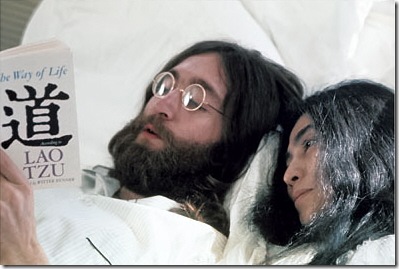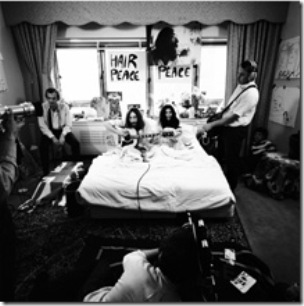Imagine. John Lennon would have turned 69 on Oct. 9.
Would he still be writing songs? Would he again curl up with Yoko Ono, nude, for a retrospective of the Two Virgins album cover? Would he still live in Palm Beach? Would The Beatles have put aside their differences and staged a worldwide farewell tour? Maybe the Nobel Peace Prize?
With four hollow-point bullets in the waning hours of Dec. 8, 1980, Mark David Chapman made certain he wouldn’t
But in Delray Beach on Friday, Oct. 9, fans young and old gathered at Old School Square to celebrate his birthday among an exhibit of photos, drawings and memorabilia that recalled a seminal event in the late icon’s life: the Montreal Bed-in of 1969.
Give Peace a Chance, a multimedia examination of the bed-in, and by extension The Beatles, that wraps up Sunday, was conceived by Joan Athey and based on her book, Give Peace a Chance: John & Yoko’s Bed-in for Peace. Athey, a former Canadian Broadcasting staffer, was inspired by photographer Gerry Deiter, who was assigned by Life magazine to cover the bed-in. He was the only journalist present for all eight days. Life, however, killed the story to make room for escalating events in Vietnam and the pictures remained closeted until Athey befriended Deiter three decades later.
There’s John and Yoko curled up together on the stark white bed, John reading Lao Tzu as Yoko nestles on his shoulder, John strumming passionately on his guitar. Hey, isn’t that Tommy Smothers (not so dumb)? Timothy Leary! Dick Gregory. Cartoonist Al Capp, who refused to sing along on Give Peace a Chance. Music writer Nat Hentoff and Crawdaddy founder Paul Williams. The essay Athey convinced Williams to contribute to her book — Doing the Bed-in for Peace — was his last work ever. It’s included in the exhibit.
“The purpose is to show people that this isn’t a piece of dead history,” Athey said. “It’s as important now as it was then.”
The exhibit is attracting lots of families, Athey said, “multi-generations, kids who are becoming caregivers for their parents.” But the Beatles and Lennon are timeless, so age doesn’t matter. It doesn’t hurt that the new remastered albums were just released.
In a way, the exhibit, like the bed-in, is part history, part performance art and part participatory art. Local artists have painted Beatles-inspired murals. A collection of guitars, exact replicas of those played by Lennon, are on display. In one corner is a “Peace Tree,” a Japanese tradition. Actually a large stepladder, children covered it with statements of peace they’d written. The notes will be sent to the Imagine Peace Tower, a light sculpture created by Ono in Reykjavik, Iceland.
Today Lennon is revered, almost deified. In the late ‘60s, he was vilified, artistically for taking up with Yoko and taking apart The Beatles, and politically for his anti-Vietnam War stand. He and Ono married in March 1969 and honeymooned with a weeklong “bed-in” for peace in the Amsterdam Hilton. The world watched with mixed reaction, but John and Yoko considered it a success and planned another for New York in May.
The Nixon administration, however, was not impressed. Citing Lennon’s previous conviction for marijuana possession, the Immigration and Naturalization Service banned his entry into the country. After an abortive first attempt in Nassau (too hot!), they began their eight-day week in Montreal’s Queen Elizabeth Hotel on May 26.
The exhibit takes on a slightly more personal tone for some because Lennon lived here, albeit briefly.
In January 1980, John and Yoko bought El Solano for $725,000. Addison Mizner built the magnificent home to be his personal residence, then sold it to Harold Vanderbilt. Later occupants included Jock McLean, who owned The Washington Post and the Hope Diamond, and his wife Brownie. After Jock died, she decided the 13,730-square-foot house was too big. She moved across Lake Worth to Trump Plaza and rented it out, among others to Lennon and to another who used the estate as background for a magazine photo shoot: Hustler’s Larry Flynt.
Strange mix, Lennon and Palm Beach. The town is home to conservative captains of commerce, hawks, wheeler-dealers, not exactly a haven for defenders of human rights. But the house was a good investment, and John must have enjoyed it. Compared to the paparazzi and fan adulation of New York, Palm Beach was downright desolate.
One morning Yoko woke up to find thousands of gardenia blossoms strewn about the house. John had ordered all he could find, some even from Texas, to surprise her on her birthday. Yoko later sold the house for more than $3 million. (Today it’s valued at $18.5 million.)
Yoko is 76. She’s still busy, still comes to Florida — Palm Beach Gardens last year, Naples this year — to sell prints of John’s artwork and keep the flame burning. She played a role in the remastering of the Beatles albums.
John Lennon was larger than life. One Internet site says he stood 5-11 and weighed 159 pounds. As he picked out cartons of Haagen-Dazs in Sunrise Health Foods in Palm Beach in the spring of 1980, he appeared closer to 5-8 and gaunt, maybe 130 pounds. With his unassuming demeanor and long ponytail, he could have been some ascetic who lived in one of the cheap rentals near the post office. Only with the sighting of Yoko browsing the shelves was the connection made.
They cleaned out the ice cream freezer, stacking the cartons on the small checkout counter, said thank you and with two bodyguards walked out.
“They love Haagen-Dazs,” a clerk said. “They’re very nice, very quiet.”
That autumn he was dead.
Thom Smith is a freelance writer based in South Florida.
JOHN LENNON AND YOKO ONO’S BED-IN FOR PEACE features 33 large-format photos by Life lensman Gerry Deiter from the Beatle couple’s eight-day anti-war demonstration at the Queen Elizabeth Hotel in Montreal in 1969. Through Sunday at the Cornell Museum, Old School Square, Delray Beach. Open 10:30 a.m. to 4 p.m. Saturday, 1 p.m. to 4 p.m. Sunday. Donation of $2 requested. Call 243-7922 or visit www.oldschool.org for more information.

